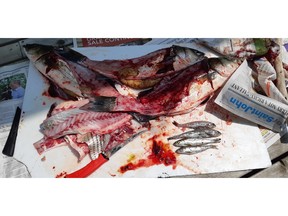Kill more striped bass to help wild salmon survive: group
Faced with record low returns of salmon on the Miramichi, conservationists want Ottawa to allow more anglers and Indigenous groups to catch one of their biggest predators

Article content
Alarmed by the record low run of wild Atlantic salmon on the Miramichi River, a conservation group wants Ottawa to allow more people to catch one of their top predators: striped bass.
The Atlantic Salmon Federation has formally asked the Department of Fisheries and Oceans, or DFO, to change the way it manages striped bass in the Gulf of St. Lawrence region.
Striped bass, once a threatened species in the early 1990s, have come soaring back thanks to DFO’s conservation measures. The number of large, mature stripers in the Miramichi estuary, their main spawning ground, has gone from a few thousand to closer to 472,000 in 2022.
What we’ve seen is drastic. Most of the mortality happens precisely where the striped bass are concentrated.
Nathan Wilbur
At the same time, the number of salmon returning from the ocean to the Miramichi River has reached its lowest point and are considered in a critical state. In 2022, the Miramichi only had 18,000 large salmon and grilse, less than half of the returns from 2010.

The 2023 figure haven’t been officially released yet, but Nathan Wilbur, a vice president at the federation, said DFO officials confirmed to conservationists at a recent meeting that it was a record low. The salmon have been in decline for decades.
“There are a number of factors affecting the health of salmon both in the marine environment and in fresh water,” he said in an interview. “But the biggest change in the Miramichi’s ecosystem since 2011 when we had a very good run of salmon has been that striped bass have gone from about 100,000 to closer to half a million.”
Striped bass, also a favourite of many anglers, are voracious eaters and one of their favourite meals is an undersized salmon.
Wilbur’s group and several others, including the Miramichi Salmon Association and Anqotum, an Indigenous conservation group, have been tracking smolt, or baby salmon, on New Brunswick rivers for more than 20 years.
For both Indigenous people and anglers, the mighty salmon remains an iconic fish in New Brunswick, a hugely important part of the province’s heritage.
In the early 2000s, they saw three-quarters of the young fish surviving on the Northwest Miramichi before going out to sea and taking the perilous, 3,000-kilometre journey to their winter feeding grounds off Greenland. Today, the survival rate of the Northwest Miramichi smolt is less than five per cent.
“What we’ve seen is drastic,” Wilbur said. “Most of the mortality happens precisely where the striped bass are concentrated. Almost no smolt are surviving through the estuary to begin their ocean journey. And the remaining few that do survive die at sea.”
The federation wants DFO to allow anglers going after striped bass a bigger bag limit than the three-a-day maximum, and to change the criteria around the minimum and maximum size that can be caught, depending on location. It also wants Ottawa to expand an existing commercial Indigenous fishery for striped bass at Natoaganeg (Eel Ground First Nation). It’s allowed to haul in 50,000 fish annually.
His group and several conservation groups say that if DFO is interested in preserving a balanced eco-system, it would aim for about 100,000 striped bass swimming in the estuary.
“Striped bass are a native species and they have a place in the ecosystem. We want to see a healthy striped bass population that supports both Indigenous and recreational fisheries for the long-term. However, we also want to see a healthy Atlantic salmon stock in the Miramichi. And we also want a healthy native fish population of foundational fish, such as smelt and gaspereau. They are important forage fish. So we want DFO to manage striped bass in such a way that will allow the other species to thrive as well.”
But DFO sounds unconvinced.
Changes in the ocean in the past 20 to 30 years, whether the ocean itself or what salmon eat and what eats salmon, are the primary factors causing the decline.
Chantal Roussel
DFO’s eastern New Brunswick recreational fisheries advisory committee heard from conservation and Indigenous groups on Jan. 11 at a meeting in Moncton, seeking their advice on the management of the recreational Atlantic salmon and striped bass fisheries in 2024.
Those management measures will be announced in the spring.
Spokesperson Chantal Roussel said the factors influencing salmon survival were complex and couldn’t be just blamed on stripers. High water temperatures and predation from a number of different species are also to blame.
“Current scientific understanding is that changes in the ocean in the past 20 to 30 years, whether the ocean itself or what salmon eat and what eats salmon, are the primary factors causing the decline and limiting the recovery of the populations to previous levels,” she wrote.

Roussel said Atlantic salmon face predation from various sources throughout their life cycle. In freshwater, eggs and fry can be vulnerable to predation by insects, birds, and other fish. As they migrate to the ocean, larger predators like birds, marine mammals and larger predatory fish may prey on smolts. In the marine environment, adult Atlantic salmon are at risk of predation by marine mammals, sharks, and larger predatory fish. Additionally, birds such as eagles and ospreys may target salmon during their return to freshwater for spawning.
Striped bass, she pointed out, are generalist and opportunistic predators of plankton, insects, crustaceans and fish.
She said predation studies conducted since 2013 by DFO, and in partnership with the Atlantic Salmon Federation, confirmed that striped bass consume juvenile Atlantic salmon.
“However, the relationships between predator and prey in marine and freshwater ecosystems are complex, as there are many factors affecting each population simultaneously,” she said, adding that DFO continues to research Atlantic salmon to understand the causes of the decline.












Postmedia is committed to maintaining a lively but civil forum for discussion. Please keep comments relevant and respectful. Comments may take up to an hour to appear on the site. You will receive an email if there is a reply to your comment, an update to a thread you follow or if a user you follow comments. Visit our Community Guidelines for more information.